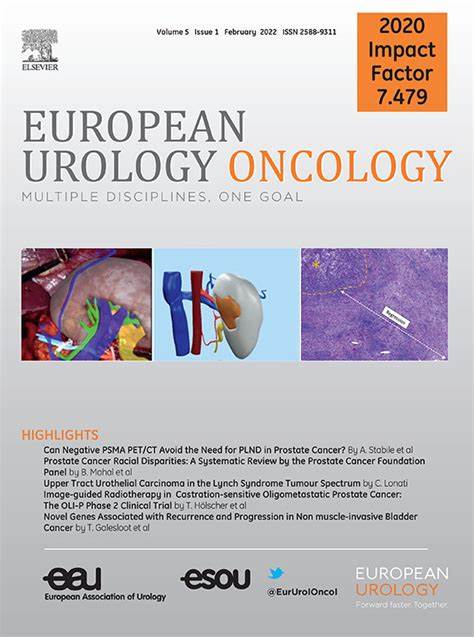Effectiveness and Cost-effectiveness of Artificial Intelligence–assisted Pathology for Prostate Cancer Diagnosis in Sweden: A Microsimulation Study
IF 8.3
1区 医学
Q1 ONCOLOGY
引用次数: 0
Abstract
Background and objective
Image-based artificial intelligence (AI) methods have shown high accuracy in prostate cancer (PCa) detection. Their impact on patient outcomes and cost effectiveness in comparison to human pathologists remains unknown. Our aim was to evaluate the effectiveness and cost-effectiveness of AI-assisted pathology for PCa diagnosis in Sweden.
Methods
We modeled quadrennial prostate-specific antigen (PSA) screening for men between the ages of 50 and 74 yr over a lifetime horizon using a health care perspective. Men with PSA ≥3 ng/ml were referred for standard biopsy (SBx), for which cores were either examined via AI followed by a pathologist for AI-labeled positive cores, or a pathologist alone. The AI performance characteristics were estimated using an internal STHLM3 validation data set. Outcome measures included the number of tests, PCa incidence and mortality, overdiagnosis, quality-adjusted life years (QALYs), and the potential reduction in pathologist-evaluated biopsy cores if AI were used. Cost-effectiveness was assessed using the incremental cost-effectiveness ratio.
Key findings and limitations
In comparison to a pathologist alone, the AI-assisted workflow increased the number of PSA tests, SBx procedures, and PCa deaths by ≤0.03%, and slightly reduced PCa incidence and overdiagnosis. AI would reduce the proportion of biopsy cores evaluated by a pathologist by 80%. At a cost of €10 per case, the AI-assisted workflow would cost less and result in <0.001% lower QALYs in comparison to a pathologist alone. The results were sensitive to the AI cost.
Conclusions and clinical implications
According to our model, AI-assisted pathology would significantly decrease the workload of pathologists, would not affect patient quality of life, and would yield cost savings in Sweden when compared to a human pathologist alone.
Patient summary
We compared outcomes for prostate cancer patients and relevant costs for two methods of assessing prostate biopsies in Sweden: (1) artificial intelligence (AI) technology and review of positive biopsies by a human pathologist; and (2) a human pathologist alone for all biopsies. We found that addition of AI would reduce the pathology workload and save money, and would not affect patient outcomes when compared to a human pathologist alone. The results suggest that adding AI to prostate pathology in Sweden would save costs.
瑞典人工智能辅助病理诊断前列腺癌的有效性和成本效益:微观模拟研究》。
背景和目的:基于图像的人工智能(AI)方法在前列腺癌(PCa)检测中表现出很高的准确性。与人类病理学家相比,这些方法对患者预后和成本效益的影响尚不清楚。我们的目的是评估瑞典 PCa 诊断中人工智能辅助病理学的有效性和成本效益:方法:我们从医疗保健角度出发,对 50 至 74 岁男性进行了四年一次的前列腺特异性抗原(PSA)筛查。前列腺特异性抗原(PSA)≥3 纳克/毫升的男性被转诊进行标准活检(SBx),通过人工智能检查核心,然后由病理学家对人工智能标记的阳性核心进行检查,或者仅由病理学家进行检查。人工智能的性能特征是通过内部 STHLM3 验证数据集估算出来的。结果衡量指标包括检测次数、PCa发病率和死亡率、过度诊断、质量调整生命年(QALYs),以及如果使用人工智能,病理学家评估的活检核心可能减少的数量。成本效益采用增量成本效益比进行评估:与病理学家单独操作相比,人工智能辅助工作流程使PSA检测、SBx手术和PCa死亡人数增加了≤0.03%,并略微降低了PCa发病率和过度诊断率。人工智能可将由病理学家评估的活检核心比例降低 80%。每例病例的成本为10欧元,人工智能辅助工作流程的成本更低,并能带来结论和临床影响:患者摘要:我们比较了瑞典前列腺癌患者的治疗效果和评估前列腺活检的两种方法的相关成本:(1)人工智能(AI)技术和由人类病理学家审查阳性活检;(2)由人类病理学家单独进行所有活检。我们发现,与仅由人类病理学家进行活检相比,增加人工智能可减少病理工作量并节省费用,而且不会影响患者的治疗效果。结果表明,在瑞典的前列腺病理检查中加入人工智能将节约成本。
本文章由计算机程序翻译,如有差异,请以英文原文为准。
求助全文
约1分钟内获得全文
求助全文
来源期刊

European urology oncology
Multiple-
CiteScore
15.50
自引率
2.40%
发文量
128
审稿时长
20 days
期刊介绍:
Journal Name: European Urology Oncology
Affiliation: Official Journal of the European Association of Urology
Focus:
First official publication of the EAU fully devoted to the study of genitourinary malignancies
Aims to deliver high-quality research
Content:
Includes original articles, opinion piece editorials, and invited reviews
Covers clinical, basic, and translational research
Publication Frequency: Six times a year in electronic format
 求助内容:
求助内容: 应助结果提醒方式:
应助结果提醒方式:


